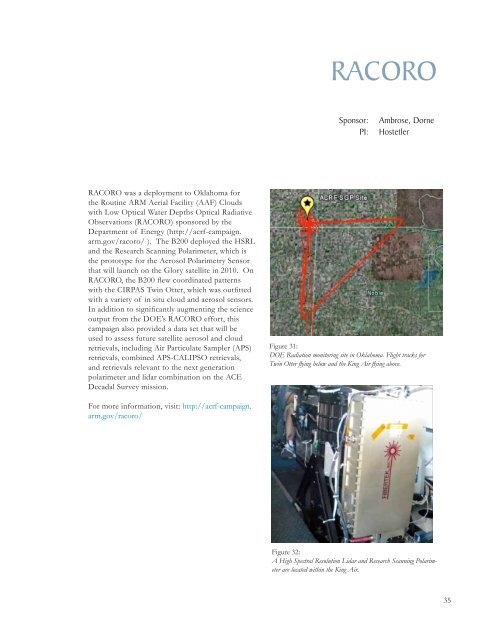2009 Annual Report - NASA Airborne Science Program
2009 Annual Report - NASA Airborne Science Program
2009 Annual Report - NASA Airborne Science Program
You also want an ePaper? Increase the reach of your titles
YUMPU automatically turns print PDFs into web optimized ePapers that Google loves.
RACORO<br />
Sponsor:<br />
PI:<br />
Ambrose, Dorne<br />
Hostetler<br />
RACORO was a deployment to Oklahoma for<br />
the Routine ARM Aerial Facility (AAF) Clouds<br />
with Low Optical Water Depths Optical Radiative<br />
Observations (RACORO) sponsored by the<br />
Department of Energy (http://acrf-campaign.<br />
arm.gov/racoro/ ). The B200 deployed the HSRL<br />
and the Research Scanning Polarimeter, which is<br />
the prototype for the Aerosol Polarimetry Sensor<br />
that will launch on the Glory satellite in 2010. On<br />
RACORO, the B200 flew coordinated patterns<br />
with the CIRPAS Twin Otter, which was outfitted<br />
with a variety of in situ cloud and aerosol sensors.<br />
In addition to significantly augmenting the science<br />
output from the DOE’s RACORO effort, this<br />
campaign also provided a data set that will be<br />
used to assess future satellite aerosol and cloud<br />
retrievals, including Air Particulate Sampler (APS)<br />
retrievals, combined APS-CALIPSO retrievals,<br />
and retrievals relevant to the next generation<br />
polarimeter and lidar combination on the ACE<br />
Decadal Survey mission.<br />
Figure 31:<br />
DOE Radiation monitoring site in Oklahoma. Flight tracks for<br />
Twin Otter flying below and the King Air flying above.<br />
For more information, visit: http://acrf-campaign.<br />
arm.gov/racoro/<br />
Figure 32:<br />
A High Spectral Resolution Lidar and Research Scanning Polarimeter<br />
are located within the King Air.<br />
35











